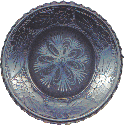
Begining
In Moldavia, one of the Romanian provinces, has been discovered incised pottery of the Cris. One of its characteristic ornament designs is of the "musical-note" kind, so called because of its resemblance to a stave with music notes. This kind of ceramics appears to be developed during the early Neolithic period and precedes the so-called Danube type with band decoration.
Painted ceramics of the Cucuteni type in Moldova seems to have originated from the East (the Dnjepr zone). Its range in this country includes nearly all Moldavia and parts of Transylvania (the bend of Olt). It is among the finest Neolithic pottery in Europe. Its forms are round, bulbous, hemispheric. The decorative design (of the first epoch, the A type), is painted in three colours (white, red and black) the background being the decorative element. The intermediate spaces are sometimes filled with hatching. The decorations are of the band type and generally consist of spirals ingeniously interwoven in a manner that denotes a remarkable decorative concept.
The potter’s wheel
The potter’s wheel, brought by Celts from the Western Europe, appeared in this country about 300 BC. This led to the appearance of the La Tene Geto-Dacian ceramics. It developed during the Second Iron Age. Its feature are: greyish-black composition, well baked, sonorous. Their varied form consists of combinations of unrounded, angular surfaces with a horizontal rim. The simple decorative design consists of wavy or parallel lines "combed in" during the turning of the wheel. With inferior material and simpler forms, the wavy decoration motifs continued throughout the period of the migrations. The shape, firing technique and decorative designs of the La Tene type of ceramics are still used to this day by some potters in the eastern Carpathians and Moldavia.
Moldavian pottery centres
Radauti, an old town and religious centre founded by Price Bogdan in the 14th century, it is one of the outstanding manufactories of north Moldavia. It is also interesting for similarity between its pottery and Oltenia were. With the importation of oriental ware like that found in the princely residences at Cotnari, Sipote,Hirlau, etc. (these fragments are of a type that resembles those found in Wallachia) the old Byzantine sgraffito technique was lost, probably at the same time as in other manufactories in the Rumanian principalities. Forms: porringers which are deeper, with pronounced angular profiles in La Tene tradition, large vessels, mugs. Ornamentation: wavy lines, spirals, sliding drops of colour. Colours: bright: green and yellow, outlined in brown.
Black pottery
Black pottery has been present without interruption on our territory since the La Tene epoch to our days, preserving down the centuries the form of simple household vessels. Manufacturing technique: the manner of cooking is the essential operation in obtaining black pottery. It has a reducing effect, changing the red colour of the clay to black. The longer the slow is firing process, the blacker the vase. Forms: fire-resisting cooking pots, vessels for curdling milk pitchers, etc. The vase are decorated before cooking by rubbing the surface with a stone or a cow’s horn. After cooking, the parts rubbed are shinier that the rest of the surface and this brings out the design.
Range of black pottery manufactories: nearly all Moldavia, (especially the mountainous parts) and south-east Transylvania.
Kuty pottery
Concurrently with the black pottery that ranges along the Carpathians until far north to Galicia, a glazed and sgraffito pottery of the Byzantine type is produced in several places, as at Cotmani; it derives of the Suceava ware used by the Bucovina, Romanian and Ruthenian population. It attained its most flourishing period in the 19th century. Forms: deep porringers, almost spherical pitchers with handles and a small mouth, and square stove-tiles. The decorative motifs are very varied: horsemen, soldiers, figures of saints, floral design, etc.
Colours: green and yellow on white background with sgraffito decoration.
